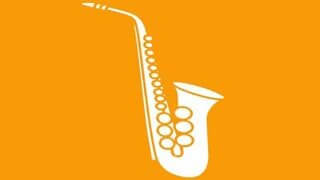[2015 10 18 addendum]
One of the questions I get from people is about special techniques.
To be honest, it’s not easy to explain on the web, though I’ve been asked to do so.
I’m not even sure my writing skills are up to the task…
special saxophone technique
Portamento
Portamento is played in a way that connects the first note to the last note. As for wind instruments, trombone is one of my favorites. It’s a little different from glissando. To master this, you’ll have to wait until you’re in advanced lip control before you can try it.
In the sample, the first solo from Gershwin’s Rhapsody in Blue, originally the clarinet, was played by I’m working on it. There’s a portamento after the first trill (which is kind of a one-shot thing, though, and not very practical. ). After that, I kind of connected the two notes with portamento. I often use the portamento technique of about 3 to 5 degrees in saxophone playing.
Portamento Sample
Siren
It’s an applied technique for portamento, and I guess it’s called this when it’s used in the fragio range. Eric Mariensal often uses this technique on his alto saxophone.
flutter
The flutter is often heard on flutes and the like, where you roll your tongue in the manner of a curling tongue, tulle tulle tulle tulle. Blow like this. Then you can hear the sound cut into small pieces. The sample is an imitation of the flutter used for the sound effects in a famous Japanese TV show.
Fazz-tone
Fuzztone is a technique (tone) that David Sanborn often uses in his playing.
It is often used in the high register of hight F hight F#. In fact, it is only effective in this range. There is also a groaning technique, but the fuzz tone and the groaning technique are different. It is. The fuzz tone is a heavy tone technique (two notes played at the same time). There are some fingering techniques that make fuzz easier to play.
Growl
Glowl, as the name suggests, is a “growl” technique.
It is a low, growling sound in the throat, like a dog threatening you. This is often required on tenor saxophone recordings, and is also required on rock saxophone Technique. Practicing throat clearing without an instrument in your mouth will not give you much of a chance to practice, so blowing the instrument and Try throttling while you do it. For the first time, I think you should start with the higher lash of the octave key.
You can play it like a fierce dog.
It’s like a Chihuahua or some small dog. I’m not going to sing a song, lol.
The way the notes are broken depends on the pitch of the grunt, so try to get used to it and practice breaking the notes more smoothly.
Quarter-tone
Practicing the quarter scale is an effective way to practice using the jaw and other parts of the jaw, as you will need to manipulate the subtleties of pitch when playing the saxophone.
The alternate fingering described below is one method of expressing the quarter note by fingering, but this sample sound source is a practice of the bended technique, which uses only jaw adjustment.
◆quarter tone fall
◆quarter tone rising
Alternate-Fingering
Half-Tonguing
It’s not a special technique for popular saxophone.
In the notation, the beginning of a note is marked with an “X” or with a “♪”.
In most cases, however, half-tangling is not notated, so you’ll need to listen carefully to reproduce it yourself.
As the expression “half-tangling” suggests, it’s half-tangling! ← As the expression goes, it’s half-tangling!
If you teach it in a lesson, you can learn how to do it in about 10 minutes, so as a technique, it’s not that difficult.
It takes more time on the expressive aspects of learning the nuances, like where to put the half-tang, than the technical aspects.
Phil Woods’ alto saxophone solo in the middle part of “Just the Way You Are” is not possible without half-tangling.
I can’t give you that nuance.
“Just the Way You Are” alto saxophone solo” for the location of the half. Check it out.
Double-TonguingTriple-Tonguing
First of all, I would like to say that in saxophone, double tangling should not be possible for amateurs!
Whereas a normal single-tangled syllable is “Tu Tu Tu Tu”, a double-tangled syllable is “Tu Ku Tu Ku” and
Ku” stops the air flow in the throat and cuts the sound.
But if you’re up to intermediate level, it’s probably best not to practice this KU, as it can be harmful.
And if you want to practice, make sure you learn it under an instructor.
There is also triple tangling in the same vein
The syllables are “Tu Ku Tu Tu Tu Ku Tu Tu Ku Tu Tu Ku Tu Tu Tu Tu” or “Tu Tu Tu Ku Tu Tu Tu Ku Tu Tu Tu Tu Tu Ku” and
I use it for triplets.
It’s not a special technique for wind instruments other than saxophone, such as flute, but it’s a necessary technique.
In this song, when the tangling is designated for a series of 16th notes, you should start playing at about this tempo. I also use double tangling. Of course, I also use single tangling in conjunction with it.
If you want this score, you can download it from the article below.
“Badinerie サックスの譜面作りました。“

